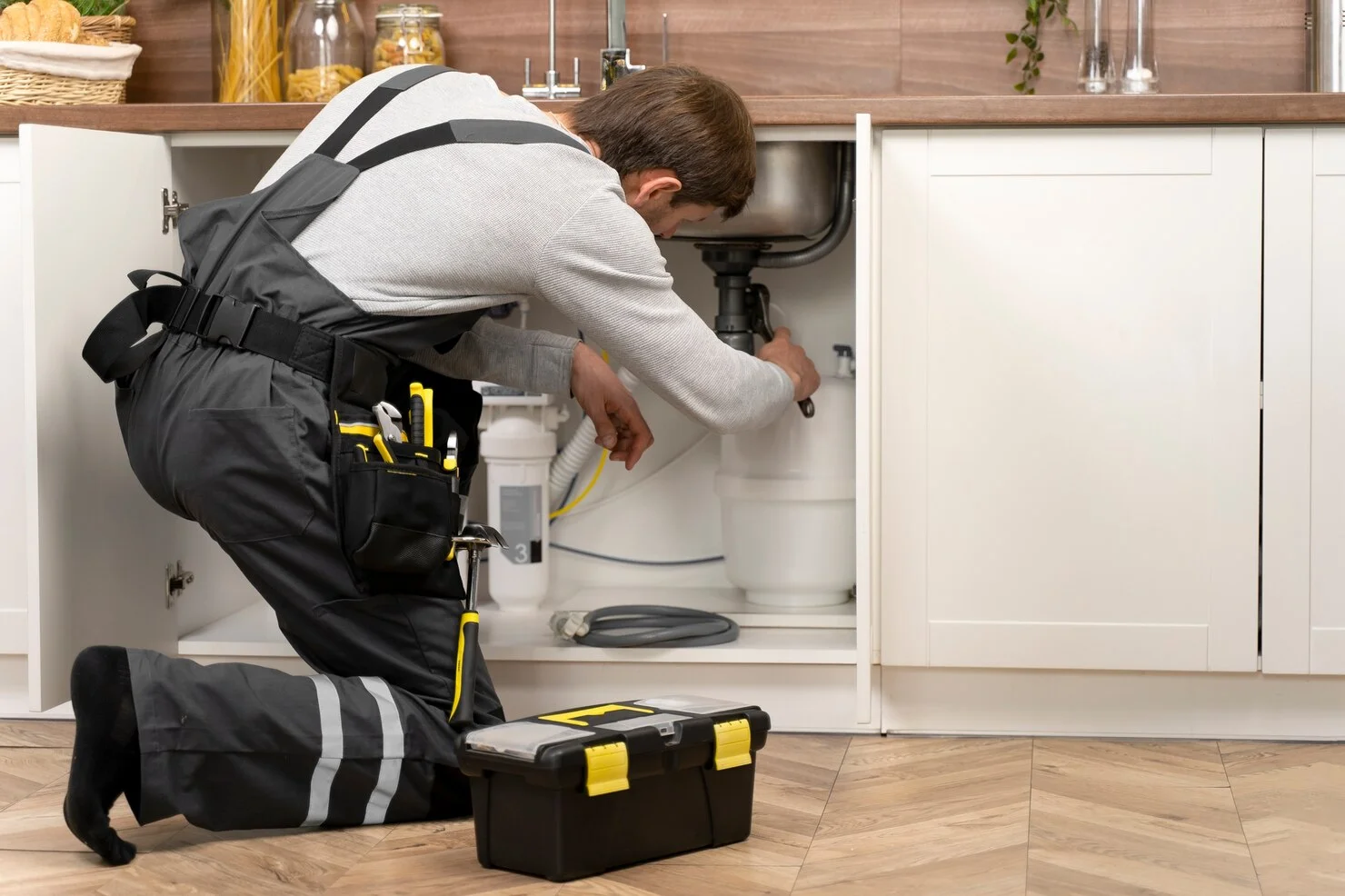HOME IMPROVEMENT
The Ultimate Guide to Sewer and Drain Cleaning: Keeping Your Pipes Flowing Smoothly

Sewer and drain cleaning might not be the most glamorous topic, but it’s a crucial aspect of home maintenance that ensures your plumbing system functions efficiently. Imagine the inconvenience of clogged drains, backed-up sewage, or foul odours wafting through your home these issues not only disrupt daily life but can also lead to costly repairs if not addressed promptly. Here, we’ll delve into the importance of regular sewer and drain cleaning, explore various methods to keep your pipes clear and offer practical tips to prevent future blockages. Whether you’re a homeowner looking to maintain your property or someone facing persistent plumbing issues, this information will equip you with the knowledge to tackle sewer and drain cleaning effectively.
Understanding the Importance of Sewer and Drain Cleaning
Sewer and drain cleaning is essential for several reasons. First and foremost, it prevents blockages that can lead to severe plumbing problems. Over time, debris such as hair, grease, soap scum, food particles, and even tree roots can accumulate in your pipes, restricting water flow and causing clogs. Regular cleaning helps remove these obstructions, ensuring your plumbing system operates smoothly.
Moreover, clean drains reduce the risk of pipe damage. When water flow is impeded, it can create pressure within the pipes, leading to leaks, cracks, or even bursts. By maintaining clear drains, you prolong the lifespan of your plumbing infrastructure and avoid costly repairs. Additionally, clean sewer lines help prevent unpleasant odours from permeating your home, contributing to a healthier and more comfortable living environment.
Common Causes of Drain and Sewer Blockages
Understanding what causes blockages in your drains and sewers is the first step toward effective prevention. Some of the most common culprits include:
- Hair and Soap Scum: Hair can easily get caught in bathroom drains, combining with soap scum to form stubborn clogs.
- Food Waste and Grease: Kitchen sinks often suffer from blockages due to food scraps and grease that solidify and adhere to pipe walls.
- Foreign Objects: Wipes, sanitary products, and children’s toys can accidentally enter the plumbing system and cause significant obstructions.
- Tree Roots: In older homes, tree roots can infiltrate sewer lines through tiny cracks, growing and expanding within the pipes to block water flow.
- Mineral Buildup: Hard water can leave mineral deposits inside pipes, gradually narrowing the diameter and restricting flow.
Methods of Sewer and Drain Cleaning
There are various methods available for cleaning sewers and drains, each suited to different types of blockages and plumbing systems. Here are some of the most effective techniques:
- Mechanical Cleaning:
- Plungers: Simple and effective for minor clogs, plungers use suction and pressure to dislodge blockages in sinks, toilets, and tubs.
- Drain Snakes and aggers are designed to reach deeper clogs. A flexible cable with a corkscrew end is inserted into the drain, breaking up and pulling out obstructions.
- Hydro-Jetting: This method involves using a high-pressure water jet to scour the inside of pipes, removing grease, mineral buildup, and tree roots.
- Chemical Cleaning:
- Enzymatic Cleaners: These environmentally friendly products use natural enzymes to break down organic material, ideal for regular maintenance.
- Chemical Drain Cleaners: Strong chemical solutions can dissolve clogs but should be used sparingly as they can damage pipes and harm the environment.
- Professional Cleaning Services:
- Video Inspection: Plumbers can use a small camera to inspect the inside of your pipes, identifying blockages and determining the best cleaning method.
- Rooter Services: For severe clogs caused by tree roots or other tough obstructions, professional rooter machines can cut through and clear the pipes.
Preventive Measures to Keep Your Drains Clear
Prevention is always better than cure, and there are several steps you can take to keep your drains and sewers clear:
- Regular Maintenance: Schedule periodic drain cleaning to remove buildup before it becomes a problem. Enzymatic cleaners can be used monthly to maintain clear pipes.
- Mind What You Flush: Avoid flushing items that can cause blockages, such as wipes, sanitary products, and paper towels. Only flush toilet paper and human waste.
- Proper Disposal of Grease: Never pour grease or oil down the drain. Instead, collect it in a container and dispose of it in the trash.
- Install Drain Guards: Use mesh screens or drain guards in sinks, showers, and tubs to catch hair, food particles, and other debris.
- Tree Root Management: If you have trees near your sewer line, consider regular root inspection and maintenance to prevent infiltration.
DIY Tips for Minor Drain Issues
For minor clogs and maintenance, there are several DIY methods you can try:
- Boiling Water: Pouring boiling water down the drain can dissolve minor grease clogs and flush away debris.
- Baking Soda and Vinegar: This natural solution creates a fizzy reaction that can help break down organic material. Pour baking soda into the drain, followed by vinegar, and let it sit for 30 minutes before flushing with hot water.
- Manual Snake: A small drain snake can be used to reach and dislodge clogs in sinks and tubs.
When to Call a Professional
While many clogs can be managed with DIY methods, some situations require professional intervention:
- Persistent Clogs: If your drains frequently clog or if multiple drains are blocked simultaneously, it’s a sign of a deeper issue.
- Slow Drains: Persistent slow draining could indicate a significant blockage or pipe damage that needs professional assessment.
- Sewage Backup: If sewage is backing up into your home, it’s a serious health hazard and requires immediate professional attention.
- Unpleasant Odors: Persistent bad smells coming from your drains might suggest a blockage or sewer line issue that needs to be addressed.
Choosing the Right Professional Service
Selecting the right professional service for sewer and drain cleaning is crucial to ensure the job is done effectively and safely. Here are some tips for choosing a reliable service provider:
- Check Credentials: Ensure the company is licensed, insured, and has certified technicians with proper training.
- Experience and Reputation: Look for a company with extensive experience in the field and positive customer reviews.
- Services Offered: Choose a service provider that offers a comprehensive range of services, including video inspections, hydro-jetting, and rooter services.
- Emergency Services: It’s beneficial to have a company that provides 24/7 emergency services for urgent situations.
- Transparent Pricing: Opt for a company that offers transparent pricing and provides detailed estimates before starting any work.
Sewer and drain cleaning is a vital aspect of home maintenance that ensures your plumbing system operates efficiently and prevents costly repairs. By understanding the common causes of blockages, employing effective cleaning methods, and taking preventive measures, you can keep your drains clear and your home comfortable. While DIY solutions can address minor issues, don’t hesitate to call in professionals for persistent problems or severe blockages. Remember, maintaining your sewer and drain system not only enhances the longevity of your plumbing but also contributes to a healthier living environment and a more sustainable approach to home maintenance.
HOME IMPROVEMENT
4 Essential Steps to Restoring a Smoke-Damaged Small Old House

Restoring a smoke-damaged small old house can be an overwhelming task. Whether it’s after a small fire or years of built-up smoke exposure, the unpleasant odor and residue can affect every corner of your cherished home.
Here’s a guide to help you through the restoration process so that you can breathe fresh air into your space and preserve its historical charm.
1. Assess the Damage and Plan
Before you begin any work, it’s crucial to assess the extent of the smoke damage. This means checking for any structural damage that may have occurred and determining the areas most affected by soot and odor.
You may want to consider bringing in a professional fire damage restoration service, especially if the smoke damage is extensive, to ensure that the assessment is thorough and that you have a clear understanding of what needs to be done
2. Ventilate and Prepare the Area
Open all your windows and doors. This helps get fresh air in and smoke smells out. If you have fans, turn them on and point them towards the doors or windows. This makes the bad air leave faster. Remember to wear masks and gloves because cleaning up smoke is dirty and might make you cough or sneeze.
Cover things you don’t want to get dirty with plastic sheets. For more help on cleaning up after smoke damage, check out https://www.rainfirerestoration.com. They have lots of tips and can do the hard work for you.
3. Clean Surfaces and Building Materials
After airing out your house, it’s time to clean everything. Use a soft cloth or sponge with warm soapy water to wipe walls, ceilings, and floors. Wood, like on doors and furniture, needs special care. Use a wood cleaner to help them look nice again. Don’t forget your windows; glass cleaner makes them shine.
If you have bricks or stone parts, scrub them with a brush and rinse with water. For soft things like curtains and sofas, you might need to wash them or use a spray to get rid of the smoke smell. It’s a big job, but cleaning helps your house feel like a home again.
4. Deep Clean or Replace Soft Furnishings
Sometimes, soft things like couches, rugs, and curtains can keep bad smells. If they smell like smoke, you need to clean them a lot or maybe get new ones. To make them smell better, you can clean them with special soap. But if the smell is still there after you clean them, you might need to buy new ones.
This helps your home smell nice and fresh. Remember, making your home restoration nice again is a big job, but it is very important. New or clean soft things can make your home feel cozy and look pretty too.
Learn All About the Small Old House
Fixing up a small old house that smells like smoke is a big job, but it’s doable! First, figure out how bad the damage is. Then, get fresh air in there and start cleaning everything from walls to carpets.
Sometimes, you might need to paint again or get new stuff if the smell sticks around. And don’t forget to keep the air clean with special machines. It might take a bit, but soon your old house will feel fresh and cozy again.
Did you find this article helpful? Check out the rest of our blog.
HOME IMPROVEMENT
Holiday Home Scent to Make Your Home Feel Festive All Year Long

Creating a festive atmosphere isn’t for the holidays. How can you keep that feeling all year? Introducing holiday home scent can transform your space.
These fragrances bring warmth and cheer, regardless of the season. Home fragrance systems play a crucial role in this transformation. They disperse your chosen scent evenly, enveloping each room.
Whether it’s the fresh aroma of pine or the inviting scent of cinnamon, the right fragrance makes a difference. Make every day feel special with the perfect home scent.
The Power of Scented Candles
Scented candles are a classic choice for bringing holiday scents into your home. They come in a variety of sizes, shapes, and scents to suit your preferences. You can opt for traditional jar candles or get creative with unique designs like floating candles or pillar candles.
These delightful additions fill the air with a cozy aroma and add a warm and welcoming ambiance to any room. You can place them on your mantel, dining table, or coffee table for an instant festive touch. And the best part? Scented candles can be used all year round, not during the holiday season.
Reed Diffusers for a Subtle Touch
For those who prefer a more subtle approach, reed diffusers are the perfect choice. These decorative bottles come with long sticks that absorb and disperse fragrance oils into the air. A gentle and consistent aroma that can last for weeks.
Reed diffusers also make for stylish decor pieces, adding a touch of elegance to any room. You can find them in a variety of designs and scents to match your home’s aesthetic. They require minimal maintenance.
Essential Oils for Customized Scents
If you desire complete control over your home’s fragrance, using recommended essential oils is the best approach. These concentrated oils are derived from natural sources and can be used in a variety of ways to create your custom scent.
You can mix and match different oils to create a unique blend that suits your taste and mood. For a warm and cozy feel, try blending cinnamon, orange, and vanilla essential oils. For a refreshing vibe, combine eucalyptus, peppermint, and lemon.
The possibilities are endless! Essential oils have various health benefits and can be used for aromatherapy. And if you’re in the mood to explore sophisticated, ready-made scents, you can purchase Santal perfume here, offering an effortlessly chic addition to your aromatic repertoire.
Aroma Machines for Whole Home Scenting
For a more efficient way to spread scent throughout the home, aroma machines are the solution. These devices use advanced technology to distribute fragrance evenly and consistently in all your rooms. They come with customizable settings so you can choose the intensity and timing of the scent diffusion.
Aroma machines are perfect for larger homes or for those who want a hassle-free way to keep their space smelling amazing all year round. They also come in various designs to fit seamlessly into your home decor.
Make Your Home Feel Festive With Home Scent
Integrating a holiday home scent creates a festive ambiance all year. Scent diffusers, like reed sticks, offer a simple, elegant solution. Candles and aroma machines add warmth and continuity.
Essential oils allow for personalized home fragrances. These methods transform any space into a haven.
The right home scent elevates mood and enhances the decor. Choose your fragrance carefully to capture the essence of the holidays every day.
Did you find this article helpful? If so, check out the rest of our site for more informative content.
HOME IMPROVEMENT
An Overview of Roof Ventilation Systems

You cannot exaggerate the critical role that roof ventilation plays in ensuring your home’s integrity and comfort. Its design promotes fresh air circulation through the attic or the space beneath. This strategic airflow regulation helps moderate indoor temperatures and protects against potential structural damage to your dwelling.
Read on to explore the essentials, importance, types, and benefits of roof ventilation systems.
Why Roof Ventilation Matters
Imagine your home when it’s hot outside. Without adequately ventilating it, the heat will accumulate in your attic, causing the mercury gauge inside your house to shoot up. Consequently, it forces your AC to work overtime. The same thing happens in winter, where you may encounter ice damming, where ice solidifies at the rooftop’s edge and obstructs water drainage. This occurrence could potentially result in leaks and subsequent damage.
A well-designed system moderates temperature extremes and prevents moisture accumulation by facilitating continuous airflow.
Critical Components of Roof Ventilation Systems
Roof ventilation systems comprise two main parts. You typically place intake vents along the roof’s lowest edge, allowing cool air to enter the attic or loft space. This inflow pushes the hot, moist air upwards and out through the exhaust vents (located at or near the peak), creating a natural flow that helps to control temperature and moisture levels.
Types of Ventilation Systems
- Ridge Vents: These run along the roof’s peak, offering a streamlined way to allow heated, humid air to escape. Many people combine them with soffit vents installed in the eaves to ensure continuous airflow.
- Turbine Vents: This type spins with the breeze to actively pull hot air out of the attic. They’re efficient but depend on the wind to function effectively.
- Static Vents: Also known as box vents, these have no moving parts. They are positioned near the roof’s ridge, allowing warm air to escape naturally, though multiple units may be necessary for proper ventilation.
- Gable Vents: These are installed at the ends of a house. They allow air movement, coming in one side of the attic and out the other. They work best when complemented by additional vent types for optimal airflow.
- Powered Vents: These are very effective and use electric or solar-powered fans to expel the hot air.
Selecting the Right Ventilation System
Choosing the appropriate ventilation system hinges on several factors, including:
- The design of your home
- Your local climate
- Specific roofing materials
Typically, a balanced approach incorporating both intake and exhaust vents proves most effective in achieving uniform temperature control and moisture regulation. Consulting roofing professionals to assess your home’s unique ventilation needs is advisable. They can recommend an optimal strategy tailored for you.
Benefits of Effective Roof Ventilation
Properly ventilating your roof confers significant advantages beyond the enhancement of home comfort. These include:
- Extending your roof’s life, thus preventing the buildup of heat and dampness, which can warp your roof decking and degrade shingles over time.
- Moderating attic temperatures, which reduces the strain on your air conditioning system. This approach potentially decreases energy bills and is one way to enhance the energy efficiency of your property.
- Adequate ventilation mitigates the risk of condensation and ice dams, preventing potential occurrences. It also safeguards against mould and rot.
Conclusion
Sufficient roof ventilation is a crucial yet frequently overlooked part of residential upkeep. It protects your home’s structure and bolsters energy efficiency. Therefore, investing in an appropriate roof ventilation system is not just advisable but economically prudent. Consulting a professional is essential to ensure your roof ventilation aligns with your specific needs. This expert guidance will assist you in navigating through the various options available to you.

 TECHNOLOGY4 months ago
TECHNOLOGY4 months agoBlog Arcy Art: Where Architecture Meets Art

 ENTERTAINMENT6 days ago
ENTERTAINMENT6 days agoExploring the Kristen Archives: A Treasure Trove of Erotica and More

 ENTERTAINMENT2 days ago
ENTERTAINMENT2 days agoKiss KH: The Streaming Platform Redefining Digital Engagement and Cultural Currents

 LIFESTYLE4 months ago
LIFESTYLE4 months agoThe Disciplinary Wives Club: Spanking for Love, Not Punishment

 LIFESTYLE6 days ago
LIFESTYLE6 days agoWho Is Sandra Orlow?

 EDUCATION2 days ago
EDUCATION2 days agoLingrohub Platform: A Complete Student Access Guide

 ENTERTAINMENT3 weeks ago
ENTERTAINMENT3 weeks agoMonkeyGG2: Your Personal Gaming Hub

 TECHNOLOGY2 days ago
TECHNOLOGY2 days agoCasibom: The Digital Alchemy Reshaping Systems, Society, and Self










